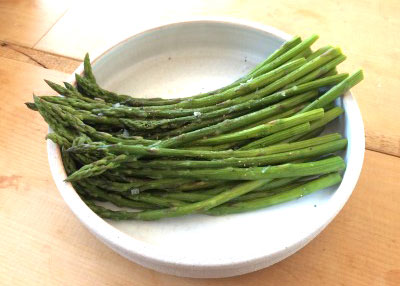Plant Asparagus Now, Harvest for Years
It’s one of the first tasks of the New Gardening Year: planting asparagus. Yet asparagus is highly unusual among vegetables in that it’s a perennial. (So are artichokes and Jerusalem artichokes, but you’re probably not growing those anyway.)
There are some critical guidelines to growing asparagus. I can’t guarantee success, but I can head you in the right direction.

Photo: Asparagus spears fresh from the garden. The colder the climate and more vigorous the plants are, the larger the spears are likely to be. (Photo courtesy Michigan State University.)
Asparagus pointers…
• Best adapted to North and Northwest Texas where nights are cooler and winters colder. This is a plant that isn’t fond of Texas’ hot weather.
• Asparagus grows best in full sun. The plants grow to be rather tall (5 to 6 ft.), so plant them in a way that they won’t shade the rest of your vegetables. Asparagus is actually fairly attractive, so you can even plant a clump as a backdrop to a wide perennial garden.
• Asparagus needs well-draining soils, preferably sandy or sandy loam. You’ll see it growing in fencerows above roadside ditches. Maybe those are just chance seedlings, or perhaps farmers planted it that way to ensure perfect drainage.
• Asparagus does best in alkaline soils (very unusual for vegetables). Gardeners with acidic soils (primarily in East Texas) will need to add lime to adjust the pH to neutral or higher.
• Asparagus plants are either male or female (dioecious). Male types will not produce the red fruit and the resulting chance seedlings that contaminate the garden. Hybrids carrying the name “Jersey” are male types. The list includes Jersey Giant, Jersey Knight and Jersey Supreme. Mary Washington, a longtime favorite, is a female selection that you might want to avoid.
• Buy vigorous 2-year-old roots from a local independent retail garden center or feed store. Beware of plants hanging in plastic bags on racks in national chain stores, especially in warm surroundings. They may already have started to grow and they may be too weak to succeed.
• Dig trenches 4 to 8 inches deep and about the same width. Space them 5 to 6 feet apart in the garden. These plants grow large.
• Use well-prepared garden soil in the bottom of each trench. Place the crowns 12 to 14 inches apart in the trenches. Cover the crowns with loose soil and firm it, but do not compact it.
• Water the freshly planted crowns slowly and deeply to settle the soil.
• As the soil in the trenches settles and as the crowns grow, gradually fill the trenches in back to the grade level.
• Apply 3 to 4 inches of loose mulch or compost to the bed to slow growth of weeds. Use a mini-tiller to eliminate any weeds that do develop, but do not till deeply lest you damage the roots.
• Water regularly and fertilize with nitrogen to keep the plants growing vigorously.
• When the first freeze kills the tops of the plants, cut the stems back to within 3 or 4 inches of the ground. By leaving the stems in place each winter they can serve as markers of where you may expect the new spears to emerge the following spring.
• You will not harvest asparagus spears until the second or third spring. The plants simply will not be strong enough.
• When your plants are old enough to produce spears, apply ammonium sulfate at the rate of 1 pound per 20 feet of row in late January to promote vigorous new spear growth. You may see recommendations that you apply a fertilizer with a significant amount of the middle number, phosphorus, but that would only apply to sandy soils that have not built up accumulations of phosphorus. Normally you will be adding nitrogen-only plant foods.
• Harvest asparagus spears as they emerge from the soil in very early spring. Harvest season lasts only six or seven weeks. From that point on you must leave the stems to develop foliage to nourish the roots for another run at vigorous growth the following spring.
• Snap or cut the stems off at or just below the ground line (never above). You can snap them with your fingers, or special asparagus knives are sold for the job.
Interested in a Texas A&M publication on growing asparagus? Here’s a good one.
